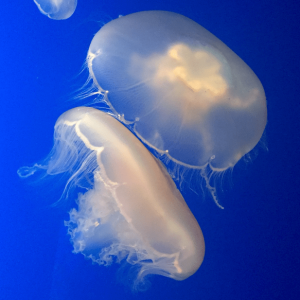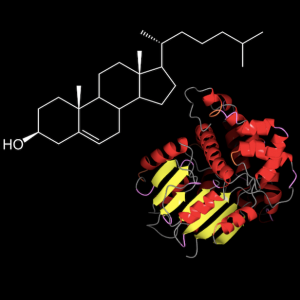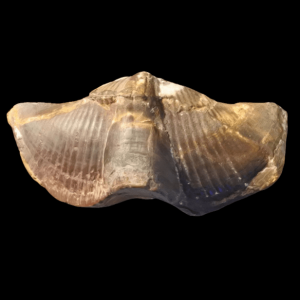The Gold Lab research program is broadly centered around the causes and consequences of animal complexity. When I say “causes”, I mean the (geologically) rapid appearance of animal fossils in the Cambrian, starting around 529 million years ago. I aim to understand how animals and the Earth co-evolved leading up to this time, and what series of events best explains the diversification of animal life. By “consequences”, I refer to the ways in which the body plans of the earliest animals continue to impact the biology of living species. I hypothesize that many aspects of animal biology–from their ability to regenerate damaged tissues to their potential to build shells in warming oceans–are dictated, in part, by the legacy of the Cambrian. My research program is divided into three areas, each offering a complementary but distinct approach. Together they offer a holistic approach to animal geobiology.
Jellyfish as early animal models
Jellyfish are the oldest living group of swimming, carnivorous animals. Our work focuses on the moon jellyfish (Aurelia coelerua). Aurelia is relatively easy to raise in the laboratory, its development is sensitive to environmental changes, and it has a suite of unusual life history traits that provide insight into the capabilities of the earliest animals. In addition to asking questions about early animal evolution, we use Aurelia as a model organism for questions regarding tissue regeneration and biological aging.
Select relevant papers:
Abrams M.J., Tan F.H., Li Y., Basinger T., Heithe M.L., Sarma A., Lee I.T., Condiotte Z.J., Raffiee M., Dabiri J.O., Gold D.A., Goentoro L. (2022) A conserved strategy for inducing appendage regeneration in moon jellyfish, Drosophila, and mice. Elife. 10:e65092. DOI Link: 10.7554/eLife.65092
Gold D.A., Lau, C.L.F., Fuong H., Kao G., Hartenstein V., Jacobs D.K. (2019) Mechanisms of cnidocyte development in the moon jellyfish Aurelia. Evolution and Development. Online ahead of print. DOI Link: 10.1111/ede.12278
Gold D.A., Katsuki T., Li Y., Yan X., Regulski M., Ibberson D., Holstein T., Steele R.E., Jacobs D.K., Greenspan R.J. (2019) The genome of the jellyfish Aurelia and the evolution of animal complexity. Nature Ecology and Evolution. 3(1):96-104. DOI Link: 10.1038/s41559-018-0719-8
Molecular Fossils
Molecular fossils are organic compounds that can be preserved in rocks, even when more traditional body fossils are not preserved. The Gold lab is particularly interested in steranes, a class of molecular fossils made from the sterol fats of eukaryotes (cholesterol is a good example). By combining organic geochemistry and genetics, we are learning how animal biology impacts the steranes that get preserved in rocks, and we are testing competing hypotheses about the organisms that could have been synthesized these compounds in the deep past. We are at a tipping point in this research; while the molecular fossil record is becoming clearer, our understanding of which organisms can produce these molecules is becoming more complicated. When it comes to molecular fossils, we appear to know more about the deep past than we do about the present! Fortunately, the rapid increase in genetic sequencing data combined with other genetic tools leaves me confident that we can resolve the outstanding questions in the coming years.
Select relevant papers:
Summons R.E., Welander P.V., Gold D.A. (2021) Lipid biomarkers: molecular tools for illuminating the history of microbial life. Nature Reviews Microbiology. DOI Link: https://doi.org/10.1038/s41579-021-00636-2
Gold D.A., Caron A., Fournier G.P., Summons R.E. (2017) Paleoproterozoic sterol biosynthesis and the rise of oxygen. Nature. 543(7645): 420–423. DOI Link: 10.1038/nature21412
Gold D.A., Grabenstatter J., de Mendoza A., Riesgo A., Ruiz-Trillo I., and Summons R.E. (2016) Sterol and genomic analyses validate the sponge biomarker hypothesis. Proceedings of the National Academy of Sciences of the United States of America. 113(10): 2684–2689. DOI Link: 10.1073/pnas.1512614113
Biomineralization
The study of how marine organisms build skeletons is the newest area of my research. Understanding biomineralization unites questions about the rise of the Cambrian fossil record with contemporary questions about climate change–as ocean acidification attributed to global warming is predicted to negatively impact the ability of marine organisms to build calcitic skeletons. We combine “omics” approaches (particularly genome assembly and RNA-Seq) with skeleton mineralogy to figure out how shells are built. Geobiology provides a distinct vantage to the problem of climate change. Geobiologists are attentive to organisms critical to geochemical cycling but understudied by biologists (such as foraminifera) and also recognize deep time patterns between ocean chemistry and the success of marine animals.
Select relevant papers:
Gold, D. A., & Vermeij, G. J. (2023). Deep resilience: An evolutionary perspective on calcification in an age of ocean acidification. Frontiers in Physiology, 14, 133. DOI Link: https://doi.org/10.3389/fphys.2023.1092321
Banker R.M., Lipovac J., Stachowicz J.J., Gold, D.A. (2022). Sodium molybdate does not inhibit sulfate-reducing bacteria but increases shell growth in the Pacific oyster Magallana gigas. Plos one, 17(2), e0262939. DOI Link: 10.1371/journal.pone.0262939
Titelboim D., Thangarjan S., Raposo D., Morard R., Kucera M., Ashckenazi‐Polivoda S., Almogi‐Labin A., Herut B., Manda S., Abramovich S.*, Gold D.A.,* Abdu, U.* (2021) The transcriptomic signature of cold and heat stress in benthic foraminifera—Implications for range expansions of marine calcifiers. Functional Ecology. 35(12):2679-90. DOI Link: https://doi.org/10.1111/1365-2435.13929



